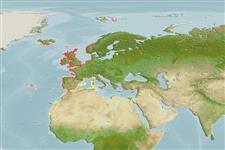Environment: milieu / climate zone / depth range / distribution range
Écologie
marin démersal; non migrateur; profondeur 0 - 8 m (Ref. 5981). Temperate; 65°N - 18°N, 32°W - 11°E
Eastern Atlantic: southern Norway to Morocco and Madeira, including the Mediterranean and the Balearics.
Length at first maturity / Taille / Poids / Âge
Maturity: Lm 8.0 range ? - ? cm
Max length : 17.0 cm TL mâle / non sexé; (Ref. 747); âge max. reporté: 10 années (Ref. 35388)
Épines dorsales (Total): 12; Rayons mous dorsaux (Total): 18; Épines anales 2; Rayons mous anaux: 18 - 19. Skin naked and slimy. No tentacles on the head. Dip in the middle of dorsal fin. Variable coloration (Ref. 35388).
Facultative air-breathing (Ref. 126274); A resident intertidal species with homing behavior (Ref. 32612) found in shallow waters of rocky coasts. May remain out of water under rocks or seaweeds (Ref. 31184). Mostly active at daytime during high tide. Breathes air when out of water (Ref. 31184). Feeds on small benthic invertebrates, especially gastropods, barnacles and amphipods, and algae (Ref. 31184). Also, diet of crabs, polychaetes, isopods, copepods, limpets, mussels and small molluscs (Ref. 94105). Oviparous (Ref. 205). Eggs measuring 1.5 mm (Ref. 35388) are demersal and adhesive (Ref. 205). Spawning takes place in April - August (Ref. 35388).
Oviparous, distinct pairing (Ref. 205). Male guards eggs from several females (Ref. 5981).
Zander, C.D., 1986. Blenniidae. p. 1096-1112. In P.J.P. Whitehead, M.-L. Bauchot, J.-C. Hureau, J. Nielsen and E. Tortonese (eds.) Fishes of the North-eastern Atlantic and the Mediterranean, volume 3. UNESCO, Paris. (Ref. 5981)
Statut dans la liste rouge de l'IUCN (Ref. 130435)
Menace pour l'homme
Harmless
Utilisations par l'homme
Pêcheries: sans intérêt; Aquarium: Aquariums publics
Plus d'informations
RéférencesAquacultureProfil d'aquacultureSouchesGénétiqueElectrophoresesHéritabilitéPathologiesTraitementNutrientsMass conversion
Outils
Articles particuliers
Télécharger en XML
Sources Internet
Estimates based on models
Preferred temperature (Ref.
123201): 9.8 - 19.3, mean 12.3 °C (based on 364 cells).
Phylogenetic diversity index (Ref.
82804): PD
50 = 0.7500 [Uniqueness, from 0.5 = low to 2.0 = high].
Bayesian length-weight: a=0.01072 (0.00480 - 0.02393), b=3.01 (2.82 - 3.20), in cm total length, based on LWR estimates for this (Sub)family-body shape (Ref.
93245).
Niveau trophique (Ref.
69278): 3.5 ±0.33 se; based on food items.
Generation time: 3.7 ( na - na) years. Estimated as median ln(3)/K based on 1
growth studies.
Résilience (Ref.
120179): Milieu, temps minimum de doublement de population : 1,4 à 4,4 années (tmax=10; k=0.3).
Fishing Vulnerability (Ref.
59153): Low to moderate vulnerability (33 of 100).
Nutrients (Ref.
124155): Calcium = 71.7 [39.0, 163.8] mg/100g; Iron = 0.421 [0.255, 0.762] mg/100g; Protein = 18.5 [17.6, 19.5] %; Omega3 = 0.548 [0.285, 1.041] g/100g; Selenium = 5.86 [2.73, 13.11] μg/100g; VitaminA = 28.3 [7.5, 104.2] μg/100g; Zinc = 0.802 [0.545, 1.171] mg/100g (wet weight);
